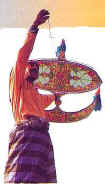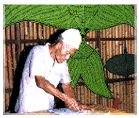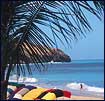| Wau or Kite in Malay is a uniquely designed Malayan kite that has flown since times past. It is called 'Wau' because the shape of its wing is similar to an Arabic letter (pronounced "wow"). It is a marvelous tradition inherent to the culture of the people, especially in the Eastern States of the Malayan Peninsula. Today, the kite is still widely found in Kelantan and Terengganu, especially during harvest time. |
|
|
One legend says that farmers used kites as a kind of flying scarecrows in the fields. The sound made by the kites lulled their children to sleep, so they could work with little interruption. Another popular belief is that coastal inhabitants once employed fishing kites made from palm leaves and fitted with a line and hook to catch fish. |
There are varying regional styles of kite-making and designs.
| In making a wau, bamboo is used for the frame. The bamboo is split and soaked in mud for two weeks. This prevents the bamboo from being attacked by weevils as well as makes it more flexible. The bamboo splits are made into a complex but lightweight frame, tested with one layer of paper and making alterations accordingly to make sure the kite is structurally sound. Next, the patterns are meticulously cut from rice-paper and glued on piece by piece to form intricate motifs. |
|
| Apart from the performance and appearance, the sound is considered important as well. The sound created or dengung as it is called, depends on the force of the wind. The higher the kite flies and the faster the wind, the higher the pitch, making the sound ... w-a-u-u-u, w-a-u-u-u. |
| There are various types of wau such as wau kuching (cat kite), wau merak (peacock kite), and wau bulan (moon kite). Each wau also comes with a different design and size. |
| 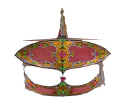 |
| Wau Bulan |
|
|
|
| 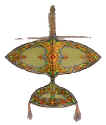 |
| Wau Kuching |
|
|
| Wau Bulan (Crescent Kite) Named because of its famous crescent-shaped tailpiece, this kite usually has a 2.5 metres wing span and height measuring up to 3.5 metres. This Light and versatile wau bulan is the favorite for competitions and are made from bamboo and paper. For a winning kite, a special bamboo, pokok buloh duri, is used. In a windy day, a wau bulan can reach a height of more than 450 metres. Malaysian Airline System has chosen it as its logo, to symbolise controlled flight. Wau Sobek Mostly used for decorations in many East Coast homes, uses bamboo and cloth. Cloth is used, as it has a nice texture and appearance but is simply too heavy to fly. |
The mark of a good kite is one that rises quickly and remains flying, no matter what the whims of the wind may be.
Tours
 Discover Malaysia States of Malaysia History Monarch Government History People Culture Festivals Holidays Handicrafts Cuisine Weather Golfing FAQ |
|
